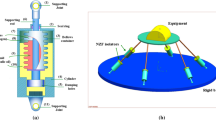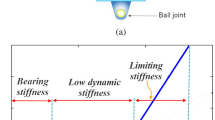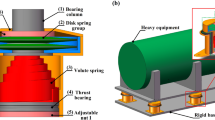Abstract
Objective
The vibration isolator with quasi-zero stiffness can achieve extraordinary isolation performance in high bands for its negligible elastic force. The novel dual-chamber solid and liquid mixture (SALiM) isolator, designed for vibration reduction of heavy machines, can obtain a quasi-zero-stiffness property in certain frequency band. This article implemented a deep analysis on the mechanism of the novel isolator.
Methods
In this work, the dynamic model of the isolator was established and the expressions of stiffness and damping were derived. Both experimental and numerical methods were adopted to study the dynamic properties of the isolator. The test was performed by a fatigue testing machine, with which both the quasi-static and dynamic test results were obtained.
Simulation
The results show that the isolator’s equivalent stiffness is frequency- and displacement-dependent. When the system is still, the isolator’s stiffness is positive to keep the load capacity and stability. When the system is vibrating, the isolator is likely to capture a negative-stiffness property, which is helpful to get excellent isolation. In the quasi-zero-stiffness band, the isolator can obtain a satisfactory performance. Therefore, the isolator has the potential to be used as substitution for the traditional dynamic absorbers in some harsh working situations. The simulation results corresponded well with the test results.
Conclusion
This paper studied the mechanism of the negative stiffness by theoretical analysis and numerical simulation, and proved the practicability of the novel isolator experimentally. Finally, comparisons with the isolation performance of the traditional isolators were made to verify its advantage.











Similar content being viewed by others
References
Kovacic I, Brennan MJ, Waters TP (2008) A study of a nonlinear vibration isolator with a quasi-zero stiffness characteristic. J Sound Vib 315(3):700–711
Carrella A, Brennan MJ, Kovacic I, Waters TP (2009) On the force transmissibility of a vibration isolator with quasi-zero-stiffness. J Sound Vib 322(4–5):707–717
Carrella A, Brennan MJ, Waters TP, Lopes V (2012) Force and displacement transmissibility of a nonlinear isolator with high-static-low-dynamic-stiffness. Int J Mech Sci 55(1):22–29
Le TD, Ahn KK (2011) A vibration isolation system in low frequency excitation region using negative stiffness structure for vehicle seat. J Sound Vib 330(26):6311–6335
Huang X, Liu X, Sun J, Zhang Z, Hua H (2014) Vibration isolation characteristics of a nonlinear isolator using Euler buckled beam as negative stiffness corrector: a theoretical and experimental study. J Sound Vib 333(4):1132–1148
Liu X, Huang X, Hua H (2013) On the characteristics of a quasi-zero stiffness isolator using Euler buckled beam as negative stiffness corrector. J Sound Vib 332(14):3359–3376
Carrella A, Brennan MJ, Waters TP, Shin K (2008) On the design of a high-static—low-dynamic stiffness isolator using linear mechanical springs and magnets. J Sound Vib 315(3):712–720
Zhou N, Liu K (2010) A tunable high-static—low-dynamic stiffness vibration isolator. J Sound Vib 329(9):1254–1273
Hoque ME, Mizuno T, Ishino Y, Takasaki M (2011) A three-axis vibration isolation system using modified zero-power controller with parallel mechanism technique. Mechatronics 21(6):1055–1062
Shaw AD, Neild SA, Wagg DJ, Weaver PM, Carrella A (2013) A nonlinear spring mechanism incorporating a bistable composite plate for vibration isolation. J Sound Vib 332(24):6265–6275
Le TD, Ahn KK (2013) Experimental investigation of a vibration isolation system using negative stiffness structure. Int J Mech Sci 70:99–112
Carrella A, Brennan MJ, Waters TP (2008) Journal of Mechanical Engineering Science 222:1189–1192 (Proceedings of the Institution of Mechanical Engineers, Part C)
Fan R, Lu Z (2007) Fixed points on the nonlinear dynamic properties of hydraulic engine mounts and parameter identification method: experiment and theory. J Sound Vib 305(4–5):703–727
Shangguan W, Lu Z (2004) Experimental study and simulation of a hydraulic engine mount with fully coupled fluid–structure interaction finite element analysis model. Comput Struct 82(22):1751–1771
Marzbani H, Jazar RN, Fard M (2014) Hydraulic engine mounts: a survey. J Vib Control 20(10):1439–1463
Li FS, Chen Q, Zhou JH (2016) Modeling and dynamic properties of dual-chamber solid and liquid mixture vibration isolator. J Sound Vib 374:61–76
Gao X, Chen Q, Teng HD (2012) Modelling and dynamic properties of a novel solid and liquid mixture vibration isolator. J Sound Vib 331(16):3695–3709
Zhou JX, Zhang L (2005) Incremental harmonic balance method for predicting amplitudes of a multi-d.o.f. non-linear wheel shimmy system with combined Coulomb and quadratic damping. J Sound Vib 279(1–2):403–416
Thomson WT, Dahleh MD (1997) Theory of vibration with applications. Prentice-Hall, Inc., Upper Saddle River
Merz S, Kinns R, Kessissoglou N (2009) Structural and acoustic responses of a submarine hull due to propeller forces. J Sound Vib 325(1–2):266–286
Chang CC (1999) Mass dampers and their optimal designs for building vibration control. Eng Struct 21(5):454–463
Hochrainer MJ, Ziegler F (2006) Control of tall building vibrations by sealed tuned liquid column dampers. Struct Control Health Monit 13(6):980–1002
Acknowledgements
This work was supported by funding of Jiangsu Innovation Program for Graduate Education (no. KYLX_0235) and the Fundamental Research Funds for the Central Universities.
Author information
Authors and Affiliations
Corresponding author
Rights and permissions
About this article
Cite this article
Li, F.S., Chen, Q. & Zhou, J.H. Dynamic Properties of a Novel Vibration Isolator with Negative Stiffness. J. Vib. Eng. Technol. 6, 239–247 (2018). https://doi.org/10.1007/s42417-018-0035-2
Received:
Revised:
Accepted:
Published:
Issue Date:
DOI: https://doi.org/10.1007/s42417-018-0035-2




